Oxford Guide to Metaphors in CBT
Building Cognitive Bridges
Richard Stott author Sam Cartwright-Hatton author Paul Salkovskis author Warren Mansell author Anna Lavender author
Format:Paperback
Publisher:Oxford University Press
Published:13th May '10
Currently unavailable, and unfortunately no date known when it will be back

Highly Commended in the Psychiatry Category, BMA Medical Book Awards 2011
This book is the first to show how metaphors can be used productively in CBT as an integral part of the treatment. It describes the use of metaphors for a wide range of problems, and brings together hundreds of metaphors that experienced therapists have used to great success. It will be a valuable sourcebook for all CBT therapists.The business of cognitive therapy is to transform meanings. What better way to achieve this than through a metaphor? Metaphors straddle two different domains at once, providing a conceptual bridge from a problematic interpretation to a fresh new perspective that can cast one's experiences in a new light. Even the simplest metaphor can be used again and again with different clients, yet still achieve the desired effect. One such example is the 'broken leg' metaphor for depression. Clients with depression are understandably frustrated with their symptoms. They may often push themselves to get better or tell themselves that they should be better by now. As a therapist, it is fair to ask, would the client be so harsh and demanding on herself after getting a broken leg? A broken leg needs time to heal and you need to begin to walk on it gradually as it builds up in strength. "You can't run before you can walk", and if you try, you are likely to make it worse. For many clients this simple metaphor is enlightening, changing their view of their symptoms as a sign of their own laziness and worthlessness, to a view of them as part of an understandable illness, that while open to improvement, cannot get better over night. This book shows just how metaphors can be used productively in CBT as an integral part of the treatment. It describes the use of metaphors for a wide range of problems, including anxiety and depression, and provides countless examples of metaphors that have been used by others in CBT. It brings together in one place hundreds of metaphors that experienced therapists have used to great success. It will be a valuable sourcebook for all cognitive behaviour therapists, as well as those training in CBT.
'Oxford Guide to Metaphors in CBT: Building Cognitive Bridges is a remarkable, memorable, and continually fascinating book, one that will be on my repeated reference list for Year to come.'Robert Leahy, Clinical Professor of Psychology in Psychiatry at Weil-Cornell University Medical College, USA
'I came away from Reading this book with a deeply enriched appreciation of the value of metaphors that will significantly impact on my clinical work. This is a book of Wisdon and great practical value that therapists of all backgrounds can benefit from. Undoubtedly destined to become a classic, and metaphorically speaking "a bright star to guide us."'Paul Gilbert, Professor of Clinical Psychology, University of Derby, UK
'This is a great contribution to the cognitive therapy literature, which will be welcomed by both students and experienced practitioners in the field. A book full of wisdom and humour, it shows how the deepest aspects of human language can reach across the apparent divide between therapist and patient towards a shared understanding that transforms live.'Mark Williams, Professor of Clinical Psychology, University of Oxford, UK
'The Oxford Guide to Metaphors in CBT is a truly exciting book, breaking much new ground in a very accessible way, and providing a fascinating theoretical background. The use of pictures is particularly engaging. This is a book I shall turn to again and again, and it is easy to imagine how the material could be shared with clients with different disorders, to enhance engagement, formulation and change.'Ann Hackman, University Department of Psychiatry, Oxford, and Oxford Cognitive Therapy Centre, UK
This was a thought-provoking book for me. For those who practice CBT, it provides a rich resource of metaphors to use in sessions with patients. Being organized by disorder makes it easily applicable to specific patients and as much a book to read as one to use as a reference. For analysts or those who practice psychodynamic therapy, it not only provides ideas of how to discuss illnesses with patients through metaphors, but it also forces one to think about the nature of therapeutic action, the many uses of metaphors with patients, and the nature of collaboration. For any therapist, it also gives a view into the evolving nature of cognitive behavioral therapy, with its many emerging branches and potential for them to either enrich each other as they currently are, or fight for hegemony, which has scarred the history of psychoanalysis. * Psychiatry *
- Winner of Highly Commended in the Psychiatry Category, BMA Medical Book Awards 2011.
ISBN: 9780199207497
Dimensions: 234mm x 156mm x 15mm
Weight: 398g
260 pages